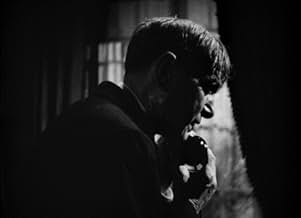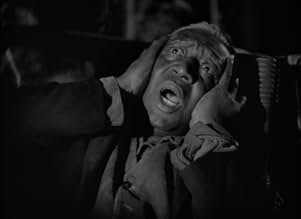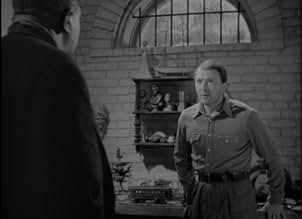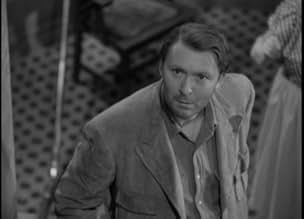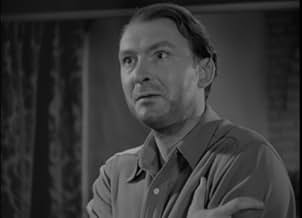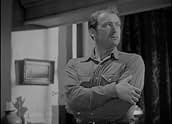A mentally unstable man who has been kept in isolation for years escapes and causes trouble for his identical twin brother.A mentally unstable man who has been kept in isolation for years escapes and causes trouble for his identical twin brother.A mentally unstable man who has been kept in isolation for years escapes and causes trouble for his identical twin brother.
Jane Allen
- Jitterbug Dancer
- (uncredited)
Rod Cameron
- Eddie - Man in Cafe
- (uncredited)
Eddy Chandler
- Motorcycle Cop
- (uncredited)
Lane Chandler
- Neighbor
- (uncredited)
Catherine Craig
- Second Mill Girl
- (uncredited)
Featured reviews
I’d always been interested in this one – not least because it involves twins (and, thus, reminiscent of the Boris Karloff vehicle THE BLACK ROOM [1935]) – so that when I came across the film, even if I knew that the quality would be far from optimal, I leapt at the chance to acquire it. While not strictly horror, it involves several elements that are part and parcel of the genre – old dark house, family secret, madness, murder, mob fury, etc.
Despite, as I said, the fact that the video was rather fuzzy – so that the images generally lacked detail – I was nonetheless struck by the film’s cinematography and editing: these were particularly effective during a scene at a bar, where the mad brother (who had been secluded all his life but has now broken loose) is ridiculed by the customers, and the one following it where he chases a girl into an alley and kills her. The two central roles are played by Albert Dekker and he does very well by both, though the mad brother is obviously the showier character – which he invests with a remarkable vulnerability (when seeing the locals indulging in a particularly animated jitterbug routine, he naively asks his future victim who’s accompanying him at the time “What are they doing?”); incidentally, despite the narrative’s Gothic – or, more precisely, Southern – trappings, the setting is a contemporary one.
The supporting cast is a good one and includes: a young Susan Hayward (that is, before she became, the First Lady of Screen Melodrama) as the perky small-town girl who entrances the crazy Dekker – which she’s all-too-willing to play up to, but who promptly and fiercely turns against him when he’s eventually revealed to be the cause of the terror which has gripped the community!; Harry Carey in the ambivalent role of the town doctor who, having been complicit in the cover-up of the mad brother’s existence, fears the repercussions of this act if he were to intervene when – at the satisfactorily frenzied climax – the good Dekker is accused of his brother’s crimes!; and the troubled Frances Farmer who, however, is wasted in the colorless role of the innocent sibling’s wife (in a virtual prerequisite of genre heroines, the actress is also asked to scream – which she does unconvincingly! – in her one scene with the mad Dekker).
The film is a Paramount production and, therefore, currently owned by Universal; while the latter have served their horror back-catalogue reasonably well on DVD, the equivalent stuff from that other studio has been consistently (and bafflingly) neglected over the years – especially since this includes such highly-desirable titles as ISLAND OF LOST SOULS (1932), MURDERS IN THE ZOO (1933) and, now, AMONG THE LIVING itself...
Despite, as I said, the fact that the video was rather fuzzy – so that the images generally lacked detail – I was nonetheless struck by the film’s cinematography and editing: these were particularly effective during a scene at a bar, where the mad brother (who had been secluded all his life but has now broken loose) is ridiculed by the customers, and the one following it where he chases a girl into an alley and kills her. The two central roles are played by Albert Dekker and he does very well by both, though the mad brother is obviously the showier character – which he invests with a remarkable vulnerability (when seeing the locals indulging in a particularly animated jitterbug routine, he naively asks his future victim who’s accompanying him at the time “What are they doing?”); incidentally, despite the narrative’s Gothic – or, more precisely, Southern – trappings, the setting is a contemporary one.
The supporting cast is a good one and includes: a young Susan Hayward (that is, before she became, the First Lady of Screen Melodrama) as the perky small-town girl who entrances the crazy Dekker – which she’s all-too-willing to play up to, but who promptly and fiercely turns against him when he’s eventually revealed to be the cause of the terror which has gripped the community!; Harry Carey in the ambivalent role of the town doctor who, having been complicit in the cover-up of the mad brother’s existence, fears the repercussions of this act if he were to intervene when – at the satisfactorily frenzied climax – the good Dekker is accused of his brother’s crimes!; and the troubled Frances Farmer who, however, is wasted in the colorless role of the innocent sibling’s wife (in a virtual prerequisite of genre heroines, the actress is also asked to scream – which she does unconvincingly! – in her one scene with the mad Dekker).
The film is a Paramount production and, therefore, currently owned by Universal; while the latter have served their horror back-catalogue reasonably well on DVD, the equivalent stuff from that other studio has been consistently (and bafflingly) neglected over the years – especially since this includes such highly-desirable titles as ISLAND OF LOST SOULS (1932), MURDERS IN THE ZOO (1933) and, now, AMONG THE LIVING itself...
'Among the Living (1941)' sits in the middle-ground between film noir and horror. The horror elements are obvious: the use of twins, representing the duality of man, recalls a more literal take on the themes of Stevenson's "Dr Jekyll and Mr Hyde." But even the "evil" twin himself is not a monster, as he is often described. Like Frankenstein's Creature, he is merely a social outcast, corrupted by the abuse of the true monsters, and who ultimately finds it impossible to assimilate into society. Like a frightened animal, Paul Raden struggles to understand the violent, cynical world in which he's been thrust, and the injustices knowingly done to him, combined with the years of abuse he endured at the hands of a dominating father, lead him to murder out of sheer terror. In many ways, Paul resembles the character of Lennie in Steinbeck's "Of Mice and Men," a simpleton with a brutish strength that he can't reconcile with his own child-like desires.
Though one would stop short of calling this a film noir, there are certainly traces of the necessary elements. Most prominent is the theme of hidden family secrets, of a shameful past coming back to haunt wrongdoers, as in 'The Strange Love of Martha Ivers (1946).' The corruptive influence of power is also referenced – as in the latter film, the primary sinner of 'Among the Living' (Raden, Sr., who is dead by the film's beginning) resides in a town that bears his name. The viewer can draw two conclusions: either that only through committing sin can a man attain power, or that from power itself is borne the desire to perpetrate crime, for he now has the means to conceal his misconduct. The latter is certainly true for the otherwise-respectable Dr. Saunders (Harry Carey), who – just once – compromised his professional integrity, and, twenty-five years later, finds that this one transgression has blackened his soul and destroyed his future.
John Raden (Albert Dekker) is the film's hapless protagonist, an honest guy who unwillingly stumbles upon his family's dirty secret. Via a succession of ill-fated coincidences, implying the forces of Fate that would later pervade the film noir movement, John finds himself on trial for murder, thrust protestingly into an ad hoc mob trial that recalls Peter Lorre's judgement in 'M (1931).' Dekker is excellent in the dual- roles of John and Paul Raden, with the "bad" half always distinguishable, not just by his grizzled beard and raggedy clothing, but by the way he carries himself: slouched shoulders, arms held awkwardly, innocent and perplexed eyes upturned at the eccentricities of this unfamiliar society. Susan Hayward plays Millie, a minor femme fatale. She's an angel when you first see her, but the way she knowingly toys with Paul's naivete is quite repulsive, and her nastiness during the courtroom trial is similarly brutal. Notably, director Stuart Heisler would progress onto full-blown noir the following year with the Hammett adaptation 'The Glass Key (1942).'
Though one would stop short of calling this a film noir, there are certainly traces of the necessary elements. Most prominent is the theme of hidden family secrets, of a shameful past coming back to haunt wrongdoers, as in 'The Strange Love of Martha Ivers (1946).' The corruptive influence of power is also referenced – as in the latter film, the primary sinner of 'Among the Living' (Raden, Sr., who is dead by the film's beginning) resides in a town that bears his name. The viewer can draw two conclusions: either that only through committing sin can a man attain power, or that from power itself is borne the desire to perpetrate crime, for he now has the means to conceal his misconduct. The latter is certainly true for the otherwise-respectable Dr. Saunders (Harry Carey), who – just once – compromised his professional integrity, and, twenty-five years later, finds that this one transgression has blackened his soul and destroyed his future.
John Raden (Albert Dekker) is the film's hapless protagonist, an honest guy who unwillingly stumbles upon his family's dirty secret. Via a succession of ill-fated coincidences, implying the forces of Fate that would later pervade the film noir movement, John finds himself on trial for murder, thrust protestingly into an ad hoc mob trial that recalls Peter Lorre's judgement in 'M (1931).' Dekker is excellent in the dual- roles of John and Paul Raden, with the "bad" half always distinguishable, not just by his grizzled beard and raggedy clothing, but by the way he carries himself: slouched shoulders, arms held awkwardly, innocent and perplexed eyes upturned at the eccentricities of this unfamiliar society. Susan Hayward plays Millie, a minor femme fatale. She's an angel when you first see her, but the way she knowingly toys with Paul's naivete is quite repulsive, and her nastiness during the courtroom trial is similarly brutal. Notably, director Stuart Heisler would progress onto full-blown noir the following year with the Hammett adaptation 'The Glass Key (1942).'
Sharp, tightly paced low budget film is hard to categorize. There are definitely noirish tendencies but it's not a full blown film noir, there are also elements of horror contained within but neither is a horror movie. Even as a hybrid of different genres it is very involving and uses it short running time to full effect, actually so effective that it received quite a lot of critical attention in its day for a lower budget release and helped move its leading lady's career forward.
Speaking of the leading lady the film is also a study of two stars in flight. Susan Hayward whose full fledged stardom was still a few years away was still definitely on her way up, Frances Farmer, whose part is small, was most definitely on the descent. At one time considered an actress with the brightest of futures this was her second to last picture before descending into a decades long hell of mental illness and involuntary confinement.
The real standout though is Albert Dekker in a dual role of very different twin brothers. An excellent character actor who met a grisly end he rarely had the opportunity of the leading role but he takes his chance here and makes the most of it. His body language and vocal inflections makes the two characters recognizably different men and their struggles relatable. Not readily available and hard to find its definitely worth the effort to seek out.
Speaking of the leading lady the film is also a study of two stars in flight. Susan Hayward whose full fledged stardom was still a few years away was still definitely on her way up, Frances Farmer, whose part is small, was most definitely on the descent. At one time considered an actress with the brightest of futures this was her second to last picture before descending into a decades long hell of mental illness and involuntary confinement.
The real standout though is Albert Dekker in a dual role of very different twin brothers. An excellent character actor who met a grisly end he rarely had the opportunity of the leading role but he takes his chance here and makes the most of it. His body language and vocal inflections makes the two characters recognizably different men and their struggles relatable. Not readily available and hard to find its definitely worth the effort to seek out.
Among the Living is directed by Stuart Heisler and written by Garrett Fort and Lester Cole. It stars Albert Dekker, Susan Hayward, Harry Carey and Frances Farmer. Music is by Gerard Carbonara and cinematography by Theodor Sparkuhl.
Dekker plays identical twins, John and Paul Raden. Paul was believed to have died when he was just 10 years old, in reality he had been traumatised and went insane and was locked up in a secret room at the Raden Mansion. When John returns for his father's funeral, he learns of Paul's existence, more so when Paul escapes and is out and about in Radentown...
1941 saw the release of Citizen Kane, The Maltese Falcon, High Sierra and I Wake Up Screaming. Films that mark an important point in the progression of what would become known as film noir, both thematically and as a visual style. Elsewhere there were some horror movies which would stand the test of time as classic productions, films such as The Wolf Man and The Black Cat are still massively popular today. Down in the lesser known file is Among the Living, a picture that blends both horror and noir for considerable rewards.
It's a slice of Southern Gothic which nods appreciatively to classic horror conventions from the previous decade (eg: the Frankenstein connection is hard to ignore but handled skillfully), and it even has social commentary bursting forth from its seams, but it's with the photographic style where it becomes a must see for film noir enthusiasts.
Heisler (latterly The Glass Key/Storm Warning) and Sparkuhl (also The Glass Key) shoot the picture by way of German Expressionism, where certain scenes and photographic compositions anticipate the noir style before it became the norm. From the feverish and frantic exuberance of a club scene, to a chase scene through menacing shadowed streets that end with murder, there are classy slices of noir before we even get to the crushing finale where Radentown is gripped by its own greed and insanity problems.
Dekker is terrific, managing to give each twin their own identity without relying on costuming for the viewers to tell the difference. His man child portrayal of Paul is heartfelt and perfectly troubling, yet always tasteful. Hayward is socko gorgeous as a vampish nymph who latches onto Paul to feather her own nest, while Farmer provides the sort of solid support she was capable of before her own personal problems would derail her potential career.
The psychological aspects of the pic are simplistic, of course, while viewing it now it's impossible to not get a sense of it being cliché heavy as regards the "twins" axis of plotting, but this is well paced, very well acted and beautifully photographed. If you can track down a decent print of it, then it's a must see for anyone interested in the influences and subsequent trajectory of film noir. 8/10
Dekker plays identical twins, John and Paul Raden. Paul was believed to have died when he was just 10 years old, in reality he had been traumatised and went insane and was locked up in a secret room at the Raden Mansion. When John returns for his father's funeral, he learns of Paul's existence, more so when Paul escapes and is out and about in Radentown...
1941 saw the release of Citizen Kane, The Maltese Falcon, High Sierra and I Wake Up Screaming. Films that mark an important point in the progression of what would become known as film noir, both thematically and as a visual style. Elsewhere there were some horror movies which would stand the test of time as classic productions, films such as The Wolf Man and The Black Cat are still massively popular today. Down in the lesser known file is Among the Living, a picture that blends both horror and noir for considerable rewards.
It's a slice of Southern Gothic which nods appreciatively to classic horror conventions from the previous decade (eg: the Frankenstein connection is hard to ignore but handled skillfully), and it even has social commentary bursting forth from its seams, but it's with the photographic style where it becomes a must see for film noir enthusiasts.
Heisler (latterly The Glass Key/Storm Warning) and Sparkuhl (also The Glass Key) shoot the picture by way of German Expressionism, where certain scenes and photographic compositions anticipate the noir style before it became the norm. From the feverish and frantic exuberance of a club scene, to a chase scene through menacing shadowed streets that end with murder, there are classy slices of noir before we even get to the crushing finale where Radentown is gripped by its own greed and insanity problems.
Dekker is terrific, managing to give each twin their own identity without relying on costuming for the viewers to tell the difference. His man child portrayal of Paul is heartfelt and perfectly troubling, yet always tasteful. Hayward is socko gorgeous as a vampish nymph who latches onto Paul to feather her own nest, while Farmer provides the sort of solid support she was capable of before her own personal problems would derail her potential career.
The psychological aspects of the pic are simplistic, of course, while viewing it now it's impossible to not get a sense of it being cliché heavy as regards the "twins" axis of plotting, but this is well paced, very well acted and beautifully photographed. If you can track down a decent print of it, then it's a must see for anyone interested in the influences and subsequent trajectory of film noir. 8/10
AMONG THE LIVING (Paramount, 1941), directed by Stuart Heisler, is not a horror film in a sense of living dead characters of "Dracula" or "The Mummy," but an original story by Brian Marlowe and Lester Cole revolving around twin brothers, one good and the other criminally insane. Starring Albert Dekker in one of his rare leading roles following his top-star title role as DOCTOR CYCLOPS (Paramount, 1940), AMONG THE LIVING was actually the studio's follow-up attempt of giving Dekker double exposure with the opportunity playing two basic characters in one basic melodrama.
The story, set in the Southern mining town of Raden, begins in atmospheric tradition, at the cemetery gathering of the burial of industrialist, Maxim Raden. In attendance are Raden's son, John (Albert Dekker) and his wife, Elaine (Frances Farmer), from New York, along with Raden's family physician and best friend of 35 years, Doctor Ben Saunders (Harry Carey). As much as John's twin brother, Paul, had died when the brothers were ten-years- old, it is soon discovered that Paul (Albert Dekker) is very much alive. Having spent years in an insane asylum from which he has escaped, he is now kept in the cellar of the decapitated Raden estate confined in a strait jacket by the family caretaker, Pompey (Ernest Whitman) until the funeral is over. Soon after, Paul is released from confinement by Pompey, whom he later kills. As Paul walks aimlessly towards the nearby town, John learns the truth about his brother and how Saunders falsified Paul's death certificate, substituting a dead child in place of Paul buried next to their deceased mother, Lucy. Fearing of being sent back to the asylum, Paul hides himself in a boardinghouse managed by landlady, Mrs. Pickens (Maude Eburne). Her daughter, Millie (Susan Hayward), takes an interest in "Mr. Paul," especially after giving her money to buy a new dress. Her involvement with the new boarder stirs up jealously from her boyfriend, Ben Oakley (Gordon Jones - Mike the cop on television's "The Abbott and Costello Show" in the 1950s). After Paul locates his brother staying with his wife at the Raden Hotel, he is soon frightened away, ending up at the River Bottom Cafe. While there, Paul makes the acquaintance with sassy blonde, Peggy Nolan (Jean Phillips), whom he likes but loses. Because she made a fool out of him, Paul follows her home and kills her. To prevent any more killings, John is advised to place a $5,000 reward for his brother's capture. The reward forms a vigilante group of greedy townspeople, especially that of Millie, still unaware of Mr. Paul's identity.
Also in the cast include: Frank M. Thomas (Sheriff Andrew Ramsey); Rod Cameron (Bill); and Clarence Muse (The Cafe Waiter). Dorothy Sebastian, a secondary actress having worked opposite such top-stars as Joan Crawford and Greta Garbo for Metro-Goldwyn-Mayer during the silent film era 1920s, appears briefly as a cafe patron surrounded by jitterbug dancers.
In spite of its second feature presentation of 68 minutes, AMONG THE LIVING is an exceptional "B" product. Albert Dekker, noted for secondary roles, gives one of his finer lead performances. In typical fashion, the good brother is ordinary while his mentally unbalanced other in unshaven face gathers the most attention. Gothic style photography and eerie underscoring offers AMONG THE LIVING added points of interest. While Frances Farmer showed great promise for her dual roles in COME AND GET IT (Samuel Goldwyn, 1936), she's virtually wasted here with nothing challenging except for facial gestures and a scream. The young and upcoming, Susan Hayward, appearing 25 minutes into the story, gets the best attention here as the flirtatious landlady's daughter who's "not afraid of anything, not even death!"
Unseen regularly on commercial television since the 1970s (notably New York City's WNEW, Channel 5, where it was last shown in 1978), AMONG THE LIVING, which has never been distributed to video cassette nor broadcast on cable television, has become available on DVD. Regardless, AMONG THE LIVING remains one of those truly obscure movies that deserves rediscovery. Even if this being just another twin versus twin theme, the performances by Albert Dekker, Susan Hayward, and sinister atmosphere rise above routine material (***)
The story, set in the Southern mining town of Raden, begins in atmospheric tradition, at the cemetery gathering of the burial of industrialist, Maxim Raden. In attendance are Raden's son, John (Albert Dekker) and his wife, Elaine (Frances Farmer), from New York, along with Raden's family physician and best friend of 35 years, Doctor Ben Saunders (Harry Carey). As much as John's twin brother, Paul, had died when the brothers were ten-years- old, it is soon discovered that Paul (Albert Dekker) is very much alive. Having spent years in an insane asylum from which he has escaped, he is now kept in the cellar of the decapitated Raden estate confined in a strait jacket by the family caretaker, Pompey (Ernest Whitman) until the funeral is over. Soon after, Paul is released from confinement by Pompey, whom he later kills. As Paul walks aimlessly towards the nearby town, John learns the truth about his brother and how Saunders falsified Paul's death certificate, substituting a dead child in place of Paul buried next to their deceased mother, Lucy. Fearing of being sent back to the asylum, Paul hides himself in a boardinghouse managed by landlady, Mrs. Pickens (Maude Eburne). Her daughter, Millie (Susan Hayward), takes an interest in "Mr. Paul," especially after giving her money to buy a new dress. Her involvement with the new boarder stirs up jealously from her boyfriend, Ben Oakley (Gordon Jones - Mike the cop on television's "The Abbott and Costello Show" in the 1950s). After Paul locates his brother staying with his wife at the Raden Hotel, he is soon frightened away, ending up at the River Bottom Cafe. While there, Paul makes the acquaintance with sassy blonde, Peggy Nolan (Jean Phillips), whom he likes but loses. Because she made a fool out of him, Paul follows her home and kills her. To prevent any more killings, John is advised to place a $5,000 reward for his brother's capture. The reward forms a vigilante group of greedy townspeople, especially that of Millie, still unaware of Mr. Paul's identity.
Also in the cast include: Frank M. Thomas (Sheriff Andrew Ramsey); Rod Cameron (Bill); and Clarence Muse (The Cafe Waiter). Dorothy Sebastian, a secondary actress having worked opposite such top-stars as Joan Crawford and Greta Garbo for Metro-Goldwyn-Mayer during the silent film era 1920s, appears briefly as a cafe patron surrounded by jitterbug dancers.
In spite of its second feature presentation of 68 minutes, AMONG THE LIVING is an exceptional "B" product. Albert Dekker, noted for secondary roles, gives one of his finer lead performances. In typical fashion, the good brother is ordinary while his mentally unbalanced other in unshaven face gathers the most attention. Gothic style photography and eerie underscoring offers AMONG THE LIVING added points of interest. While Frances Farmer showed great promise for her dual roles in COME AND GET IT (Samuel Goldwyn, 1936), she's virtually wasted here with nothing challenging except for facial gestures and a scream. The young and upcoming, Susan Hayward, appearing 25 minutes into the story, gets the best attention here as the flirtatious landlady's daughter who's "not afraid of anything, not even death!"
Unseen regularly on commercial television since the 1970s (notably New York City's WNEW, Channel 5, where it was last shown in 1978), AMONG THE LIVING, which has never been distributed to video cassette nor broadcast on cable television, has become available on DVD. Regardless, AMONG THE LIVING remains one of those truly obscure movies that deserves rediscovery. Even if this being just another twin versus twin theme, the performances by Albert Dekker, Susan Hayward, and sinister atmosphere rise above routine material (***)
Did you know
- TriviaJane Allen's debut.
- Quotes
Mrs. Pickens: I had one of them Frenchmen living here last year. Honest to goodness every time you'd turn 'round, that Frenchman was grabbin' your hand and kissing until he'd like to pull the skin off.
- How long is Among the Living?Powered by Alexa
Details
- Runtime
- 1h 7m(67 min)
- Color
- Sound mix
- Aspect ratio
- 1.37 : 1
Contribute to this page
Suggest an edit or add missing content

